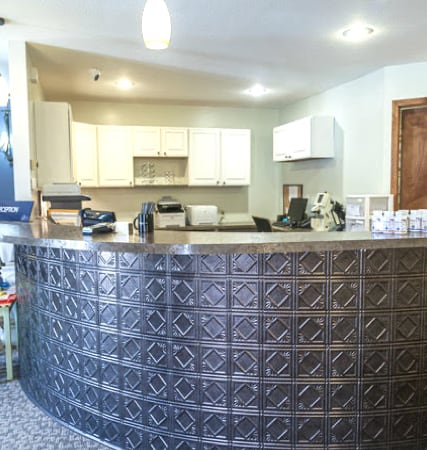Finding Relief
No matter what may be causing your symptoms, our team is committed to finding strategies that work for you.
When you come in for your appointment, we’ll perform a comprehensive eye exam using comfortable, modern technologies, like the Keratograph 5m corneal topographer, to get a detailed look at your eye health and tear film quality.
We can recommend in-office treatments for issues like meibomian gland dysfunction or provide an eyelid cleansing routine that you can perform at home. Some of our in-office treatments have no downtime, which means you can return to your normal routine immediately after your appointment!
Lumenis Intense Pulsed-Light Therapy
Intense pulsed light (IPL) therapy is a popular dry eye treatment for patients that have dry eyes caused by MGD. During this treatment, your optometrists will use therapeutic light technology to warm up your meibomian glands, which can help melt the blockages preventing a healthy flow of oils to your tear film. If your tears can return to their normal level of function, you should see a decrease in dry eye symptoms.
Depending on your dry eye symptoms and individual needs, you may require multiple IPL treatments over a few weeks. In some cases, you may need to have ongoing IPL treatments to manage severe MGD.
MiBo Thermoflo Thermal Heating
MiBo Thermoflo, also known as MiboFlo, is an effective and non-invasive treatment that can reduce dry eye symptoms. This thermal heating treatment has a similar goal as IPL therapy: warming the meibomian glands to help loosen and melt blockages caused by MGD.
During this treatment, your optometrist will apply small heating elements to your eyelids. These elements are precisely placed to heat the meibum in your eyelid. The entire treatment only takes a couple of minutes, and you can return to your normal routine immediately after your appointment.
OptiLight by Lumenis
OptiLight by Lumenis is a light-based, non-invasive dry eye treatment that targets the root cause of dry eye disease – chronic inflammation. This safe and gentle treatment is drug and drop-free, and only uses pulses of light to reduce inflammation, improve tear break-up time, and increase meibomian gland functionality.
Eyelid Cleansers, Heating Masks, & Eye drops
Eyelid hygiene cleansers, heating masks, and eye drops are some frequent dry eye treatments we offer. You can perform some of these treatments at home, but we can determine if your dry eye symptoms need in-office treatment when you come in for your appointment.
Soothe Your Dry Eye Symptoms Today
If your eyes are constantly irritated, watery, and uncomfortable, where can you go to find the help you need?
InVision Family Eye Care is prepared to help you find soothing relief from dry eye symptoms with the help of our modern treatment options and holistic approach to eye care.
Let us help bring comfort and clarity back to your vision and book your appointment today.
Millions
Struggle with Dry Eye
Even if you regularly struggle with eye comfort, it might be reassuring to know that you’re not alone.
Dry eye is among the most common eye problems in the United States, affecting an estimated 16 to 49 million Americans. Because of its prevalence, we’ve made it our mission to provide several treatments suitable for all ages.
The risk of dry eye can increase as you age, but health conditions, eye conditions, and even your genetics may also lead to dry eye problems. If you’re one of the millions of people who are seeking relief from uncomfortable eye problems, make sure you’re having regular eye exams.


Looking at Your Tear Film
Your tear film is responsible for so much of your eye comfort, and it depends on mucus, water, and oil to perform its job correctly. However, an imbalance of these ingredients can lead to dry eye symptoms. Even if you’ve never been diagnosed with dry eye, we recommend seeing our team if you regularly experience:
- Stinging
- Discomfort
- Contact lens problems
- Light sensitivity
- Redness
- Wateriness
- Blurry vision
- Mucus discharge
There are 2 types of dry eye: evaporative dry eye and aqueous tear deficiency. Evaporative dry eye occurs when your tear film doesn’t get the oil content it needs to prevent your tears from evaporating too quickly. Aqueous tear deficiency develops when your tear film doesn’t have enough water to hydrate your eyes.
Evaporative dry eye is the most common form of dry eye, with meibomian gland dysfunction (MGD) being the primary cause of the issue. In fact, MGD is prevalent in over 40% of adults, even if they don’t experience symptoms.
Common Causes
While many dry eye symptoms stem from tear film problems, causes can vary from person to person. Several factors can increase the risk of dry eye, including:
- Age
- Contact lenses
- Previous eye surgeries
- Health conditions (rheumatoid arthritis, Sjogren’s syndrome)
- Hormonal changes
- Medications
- Vitamin A deficiencies
- Windy, smoky, dry environments
- Allergies
Helping You Achieve Comfortable, Hydrated Vision
Even though millions of people struggle with dry eyes, we can help support your eye comfort.
Find the relief you need by booking an appointment with our team today.
View Our Location

Our Address
- 1211 Hauck Dr.
- Rolla, MO 65401
Contact Information
- Phone: 573-364-6300
- Fax: 573-341-5058
Our Hours
- Monday: 8:30 AM – 5:30 PM
- Tuesday: 8:30 AM – 5:30 PM
- Wednesday: 10:30 AM – 5:30 PM
- Thursday: 8:30 AM – 5:30 PM
- Friday: 8:30 AM – 1:00 PM
- Saturday: Closed
- Sunday: Closed
Our Brands




















